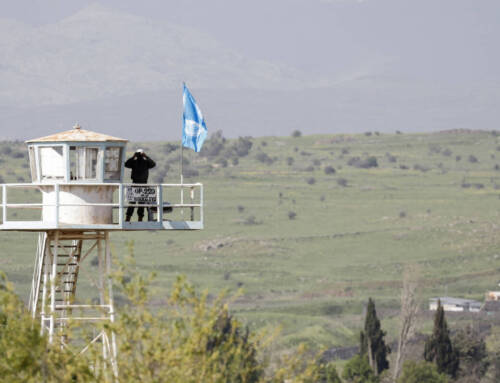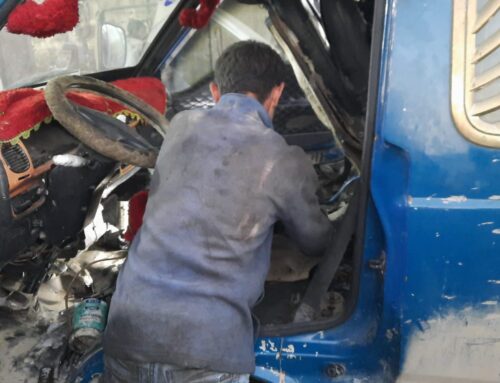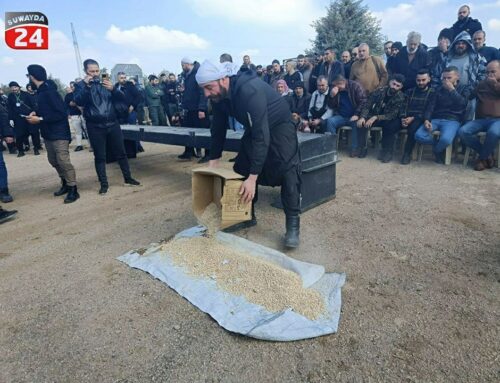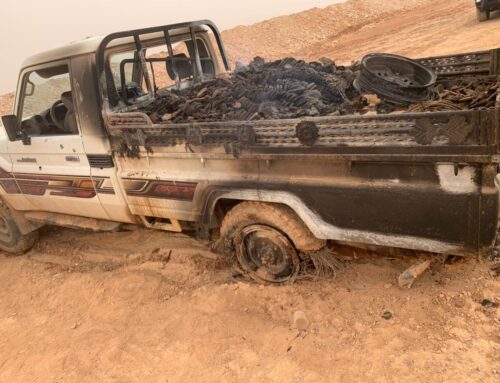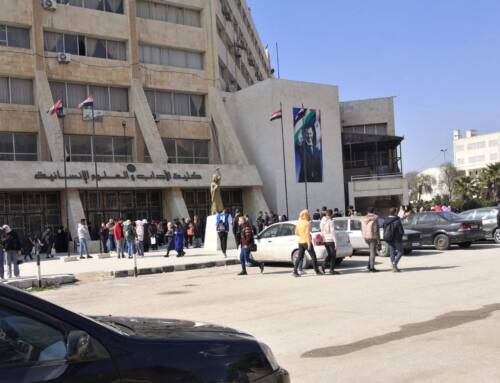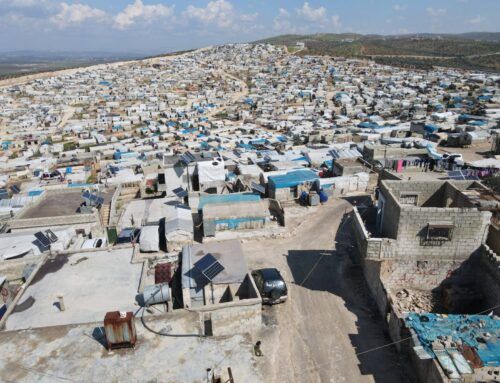‘No clear path forward’ as Syrian government, rebel factions and international powers brace for possible Idlib battle
HTS fighters conduct military training exercises in Idlib in August. […]
11 September 2018

After pro-government bombardment dramatically escalated this week across northern Hama and southern Idlib, 70,000 fighters from myriad rebel and hardline Islamist groups are busy digging in and bracing for what may soon be their last stand.
Political discussions have stalled, and talk is growing of an imminent ground campaign to crush what remains of Syria’s armed uprising. The complexities of Idlib’s factional landscape—defined by overlapping armed rebel entities and territories—means that areas of control often blur from one group to the next. Hardline Islamist elements, largely dominated by Hay’at Tahir a-Sham (HTS), often overlap with Turkish-backed forces, including those of the National Liberation Front (NLF) as well as smaller, independent militias.
The province lies at a crucial geopolitical crossroads—pinned between encroaching pro-government frontlines around northwest Syria, Turkey, self-governing Kurdish enclaves to the east as well as Turkish-occupied regions of neighboring Aleppo province. Each and every actor has a stake in Idlib’s future.
The Syrian government and its allies are busy bolstering a growing force poised for an offensive on the peripheries of Idlib, while Turkey is seeking to isolate HTS from other rebel formations. The seeming failure of last week’s Tehran summit between the leaders of Iran, Russia and Turkey to reach concrete proposals for next steps leaves Idlib’s future yet further in doubt.
“There really is no clear path forward, which raises the likelihood that if this does go to a full offensive, it will be a very bloody one,” says Christopher Kozak, a senior analyst at the Institute for the Study of War in Washington DC.
In an interview with Syria Direct’s Barrett Limoges, Kozak analyzes Idlib’s military landscape and the potentially dire future for seemingly irreconcilable Islamist factions including HTS.
With no place left to displace tens of thousands of jihadists to, he says that many hardliners see little alternative other than a fight to the death.
“There is nowhere else they can be evacuated to…no clear destination for the green buses,” says Kozak.
Q: There have been several reports in recent weeks of Syrian government deploying more and more ground forces near Hama and Idlib provinces, but do we know where those troops are being stationed?
Over the past month, we’ve seen a steady buildup of pro-government forces around the outskirts of greater Idlib province. A lot of these forces have been what I term elite pro-government forces: the ones the government can really rely upon and that it has leveraged extensively throughout the Syrian [conflict], as the troops who actually seize and hold terrain. That includes the 4th Armoured Division, Republican Guard units [and] Tiger Forces. So forces the government has extensively used in offensive operations, as opposed to some of the regular Syrian Arab Army conscript units that are primarily good for cities and garrison areas rather than actually capturing terrain. This is the cream of the crop—the forces that have really done the heavy lifting in the Syrian civil war.
We have also seen regular Syrian Arab Army units, even from the 1st Division. We’ve [also] seen elements of other pro-regime paramilitary groups. For example, we have reports that reconciled opposition fighters from northern Homs province and Daraa province in southern Syria are allegedly also being deployed in small numbers to Idlib under the auspices of the 5th Assault Corps. So these new units have been [formed] by Russia to pull together pro-regime paramilitary groups and reconciled opposition fighters and put them under some formal command structure linked to Russia and the Syrian Arab Army.
Of course, there are also Iranian proxy forces—Liwa Imam al-Hussein and others. Although the Iranian proxy forces are still primarily concentrated in eastern Syria around Abu Kamal and that area, we have also seen Iranian-backed units in Idlib.
Q: Do those deployments suggest what an imminent offensive might look like, in your view?
I would really point to two areas…where I would expect a limited offensive to occur. We’ve primarily seen a concentration in northern Hama province and southern Aleppo province—you [also] have a southeastern sector of greater Idlib province, in the area of Khan Sheikhoun and Morek, along that frontline there—as well as in northern Latakia province and the [Sahel] al-Ghab plain in western Hama, near the city of Jisr a-Shughour in western Idlib province.
We’ve already seen airstrikes in Jisr a-Shughour,the al-Ghab plain and northern Hama province by the Syrian air force as well as by the Russian air force, which would be the preliminary step of softening up the fixed positions held by opposition groups—[ahead of] pro-government offensives.
Q: What are some of the major rebel positions along these frontlines? Who’s controlling most of the strategic territory around Jisr a-Shughour, for example, given that the Syrian government clearly targeted that area when bombardments escalated last week?
Jisr a-Shughour is currently dominated by the Turkistan Islamic Party, which is an extremist group linked to Al-Qaeda, [made-up] primarily of Uighurs from central Asia as well as the Uighur diaspora in Turkey, who have relocated to Jisr a-Shughour.
Jisr a-Shughour is very much a flashpoint for Al-Qaeda-linked groups, particularly the Turkistan Islamic Party. [Nearby] northern Latakia province in particular has been a garrison point for Chechen fighters and other forces, as well as some Free Syrian Army affiliates—but [Jisr a-Shughour] is more dense than usual with foreign fighters linked to the Al-Qaeda movement or at least to the global Islamic jihadist movement.
Pro-government Tiger Forces arrive in Hama in September. Photo from a Tiger Forces-affiliated Facebook page.
Overall, Idlib is really dominated by two factions: HTS and the National Liberation Front [NLF], which is a loose coalition backed by Turkey that includes Islamists and Free Syrian Army-affiliated groups—one of the most prominent of which is Salafi jihadist group Ahrar a-Sham, one-time partner and rival of HTS.
Most of the frontline positions that we’re looking at—if you start at Jisr a-Shughour, move down the al-Ghab plain to northern Hama province—are really a mix. I would say that HTS and its affiliates hold some of the more strategic terrain, particularly in Jisr a-Shughour and the high ground there. But this is not necessarily an offensive that would spare anyone or be laser-focused like a scalpel on Al-Qaeda at the expense of other opposition groups.
Northern Hama province is a mix of NLF, HTS and other groups like Jaish al-Izza. This is part of the perennial problem with Idlib—the whole concept that you can easily separate the “terrorists” from the rest of the armed opposition doesn’t work in practice because [in] a lot of these areas, they are intermingled. There is a an HTS branch in a village, and an NLF branch or Ahrar a-Sham branch in a village. So it becomes very difficult to draw clean maps and delineations.
There are areas that are more dominated by HTS than others, such as near the Turkish border, Idlib city [and] Jisr a-Shughour, but it definitely isn’t exclusive.
Q: Turkey will play a key role in any of the possible futures for Idlib province, and in terms of the looming pro-government offensive. Do you see the Turks wanting to maintain a sphere of influence in the long term that would look similar to the authority they now wield in northern Aleppo province, or do you think Idlib will be fully reintegrated into the state?
I think Turkey does want that. Turkey wants to preserve a zone of control directly along this border where it can manage IDP flows, where it can repatriate refugees from Turkey. And so I do think their ultimate goal would be maybe not all of Idlib province, but certainly the stretch closest to the border, to create that Euphrates Shield-esque zone, that buffer zone in Idlib province.
[Ed.: Euphrates Shield was the name given to a Turkish-led military operation launched in August 2016 to seize a stretch of Syria’s northern borders with Turkey from the Islamic State and Kurdish-majority Syrian Democratic Forces. The area is now under the control of Turkish-backed Syrian opposition groups.]If we do go through a limited offensive, I expect that Turkey is going to try to draw the line—telling Russia, Iran and the government that they can slice off parts of the fringes of Idlib and eventually bring much of it back under state control in exchange for continued Turkish influence and presence in this smaller buffer zone.
Turkey has a hand to play here, but it’s not the strongest hand. They are relatively isolated at this stage in the game.
So Turkey—or Erdogan—really has to balance what’s in its best interest, which I think, over the long run, looks like a intermediate stage where Turkey does have this buffer along the Idlib border. But ultimately, over the longer term—and I don’t know how much longer that is—[Turkey] is pressed to concede control over that area back to the [Syrian] state in exchange for certain other concessions, probably in Afrin and northern Aleppo province. Those areas [Afrin and northern Aleppo] are much more core to Turkish interests, given their concerns about the Kurds and the Syrian Democratic Forces.
Q: Regarding the ultimate fate of the HTS fighters, the Turks don’t want to take them in; surrender to the Syrian government could mean imprisonment or death. What outcome do you see for the tens of thousands of hardline fighters in and around Idlib?
This is the million dollar question. From what I have seen, allegedly what the Turks have been bringing to the table looks something like giving safe passage for foreign fighters to leave Idlib, ostensibly to Turkey and from there to somewhere else. There are allegedly quiet efforts going on to repatriate some of these foreign fighters before the offensive starts. So foreign fighters are trying to leave at this point. That’s allegedly being facilitated by Turkey, which has also facilitated the flow of a lot of these foreign fighters into Syria to promote its own interests
Over the past two weeks, Turkey has been working on a program to convince HTS to disband itself and dissolve into the wider milieu of opposition Syria—whether it’s local fighters going to join the NLF, and foreign fighters being given safe passage out of Syria—in order to try once again to deter, dissuade or convince the Russians and Iranians not to launch an offensive operation into Idlib province.
But those negotiations, from all the reports that we’ve seen, seem to have really broken down. [Abu Muhammad al-] Jolani, the emir of HTS, released a statement basically denouncing any form of reconciliation and talking about people giving up their guns, saying that some [rebel groups] have already given up theirs. So the opposition is entering this fight with, ostensibly, at least some coordination of defense but…there really doesn’t appear to be a strong viable command structure that controls all opposition forces in Idlib.
In terms of the Syrian fighters, I think the end goal that Turkey sees as realistic is that the Syrian fighters are blended into this National Liberation Front, a national army that they’re building along their border, and that some chunk of Idlib survives, maybe right along the Syrian-Turkish border as kind-of a buffer zone that these guys can be dispersed in, [running] from Salqin [in northern Idlib] and the border area up and through Afrin to Manbij. That’s probably the best-case scenario for these fighters, and that’s the one I think Turkey is pushing for as the soft landing. Not least of which because Turkey also would have concerns if these people are pushed toward the border in large numbers and have an axe to grind against Turkey for not helping them.
The alternative at this point is to fight and die in place, honestly. There is nowhere else they can be evacuated to. There is no clear destination for the green buses. There really is no clear path forward, which raises the likelihood that if this does go to a full offensive, it will be a very bloody one.




